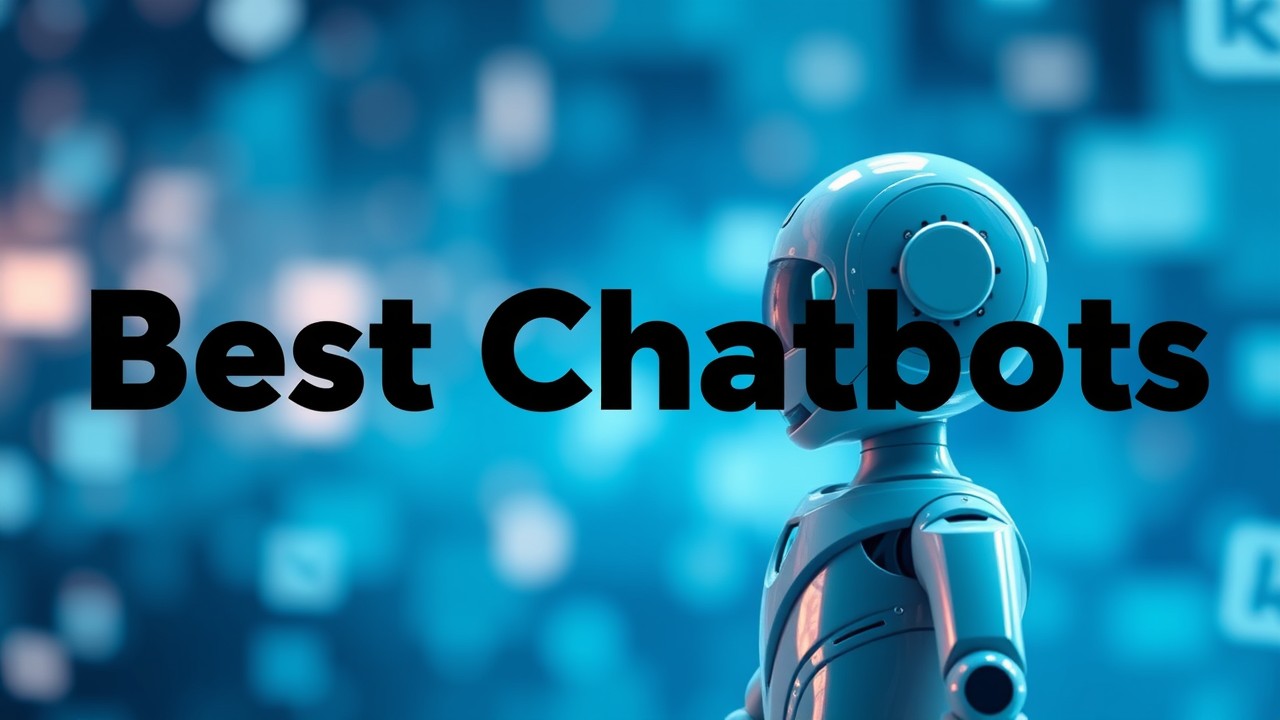Introduction
It’s 2024, and if you have not yet adopted the AI chatbot trend, you are overlooking a significant revolution. Having gained considerable experience in the field, I can confidently say that these agile assistants work their cutting-edge magic on enterprises of all kinds, regardless of their size. In this article, I’ll take you on a journey through the 7 best AI chatbots out there, so you can find the perfect match for your business needs.
I’ll keep it simple and instead of giving you just a generic idea on what Chatbots are, I’ll make it actionable! I’ll teach you what are the different kinds of Chatbots and more importantly, what would be the best chatbot for your business and use case. Towards the end, I’ll also run you through the steps to successfully implement a Chatbot in your business and the best practices for Chatbot adoption.
Let’s get started!
The AI Chatbot Revolution for Businesses
Let’s just get the definition of a Chatbot out of the way before we proceed.
What is an AI Chatbot?
An AI Chatbot is a computer software tool that is trained using Natural Language Processing (NLP) to mimic human conversations.
Put it simply, it’s a software tool that helps you answer questions for your customers that would have otherwise needed a human
Picture this: It’s 2 AM, and a potential high value customer has a burning question about your product. It’s not a particularly difficult question and at any other time of the day, it would have been a quick resolution. But who is going to answer it at 2AM?!!
Till now, you had to rely on a customer support agent that you hired or a generic Chatbot.
Generic chatbots can only answer predefined questions. It can’t search through your documents and give contextual personalized answers. Also, they lack the ability to hold the conversation with your high value customer both to engage them, and to convert them into a lead.
This was the problem pre 2024. Not anymore!
The new-age digital assistants work 24/7, providing instant support and engagement, so you can focus on growing your business. Plus, they’ll never call in sick or ask for a raise. Talk about a win-win situation!
In 2024, Chatbots have gotten so good that most of your customers won’t be able to discern a human from a chatbot. At least for the simple queries.
Chatbots like ChatCube have the ability to be trained on your business documents to immediately answer your customer queries. It takes 2 min to train on your website’s content and it’s FREE ! I’d say it’s worth a shot to check it out at least.
Can my business sprint without an AI Chatbot?
Now, I know what you might be thinking: “My business is doing just fine without an AI chatbot.”
But trust me, you don’t want to be left behind in this marathon – you want to cross the finish line first. AI chatbots can help you do exactly that, through the following ways:
– Improve customer satisfaction with quick, accurate responses that are grounded in your business documents.
– Increase sales by guiding customers through the buying process. These bots have the ability to give hyper personalized responses
– Save time and money on customer support and lead generation. AI chatbots are now smart enough to understand what they can and cannot answer. You can explicitly instruct the chatbot to seamlessly hand over the conversation to a human agent if they are unable to answer a specific query.
– Gain valuable insights into customer behavior and preferences. The newer age Chatbots also provide analytics on the kind of queries that your customers are asking so that you can improve your product along those lines.
So, let’s dive into what makes a great AI chatbot and explore the top 15 options for your business in 2024.
What to Look for in an AI Chatbot
Essential features and capabilities
When shopping for an AI chatbot for your business, you’ll want to keep an eye out for these key features:
1. Natural Language Processing (NLP): Your chatbot should understand and respond to customer queries in a natural, human-like way.
2. Multi-channel support: Look for a chatbot that can seamlessly integrate with your website, social media, and messaging apps.
3. Customization options: Your chatbot should reflect your brand’s personality and adapt to your specific business needs.
4. Analytics and reporting: A good chatbot will provide valuable insights into customer interactions and help you make data-driven decisions.
5. Ease of Retraining: Your business documentation keeps changing. The chatbot needs to be able to adapt to these changes quickly and provide your customers with the most up-to-date responses.
I know it’s a shameless plug, but ChatCube has all of these! You can create a chatbot on your documentation in minutes. It’s super easy to integrate into your existing workflows and provides enough customization options to match your brand identity.
Factors to Consider for Businesses
As a business owner, you’ll also want to consider the following factors when choosing an AI chatbot:
1. Ease of use: Your chatbot should be simple to set up and manage, even if you’re not a tech wizard.
2. Scalability: As your business grows, your chatbot should be able to handle increased customer interactions without breaking a sweat.
3. Pricing: Look for a chatbot that offers transparent, flexible pricing plans that fit your budget. You don’t want surprises here
4. Integrations: Your chatbot should play nicely with your existing business tools and systems, such as your CRM or e-commerce platform.
Now that you know what to look for, let’s meet the top 15 AI chatbots of 2024!
7 Best AI Chatbots in 2024
Most blogs give you a dump of the top 15 chatbots with all of them having more or less the same features. These are also not differentiated by their use-cases.
Here’s your definitive list of AI chatbots in 2024 split by use-case. I’ve also included a couple of alternatives for each of these in case you want to check them out.
Chatbot 1: ChatGPT – The OG of AI
Overview and Key Features
Ah, ChatGPT. The one that started it all. This big brain of an AI chatbot, trained by the geniuses at OpenAI, is like having a walking, talking encyclopedia at your fingertips. Well, minus the walking part. With its incredible knowledge spanning more topics than you can shake a stick at, ChatGPT can carry on conversations that’ll make you forget you’re talking to a machine.
Key features:
– Generates human-like text that’ll make you do a double-take
– Answers questions, explains concepts, and helps you write like a pro
– Learns from every interaction, so it’s always improving (unlike some humans I know)
– Speaks multiple languages and can adapt to your writing style (it’s a real chameleon, this one)
Where to use in businesses
While ChatGPT is a jack-of-all-trades, it really shines in a few specific areas:
1. Learning and development: Create engaging training materials and answer employees’ burning questions
2. Product development: Whip up product requirements documents (PRDs) and user stories like a pro.
3. Email writing: Craft compelling emails that’ll make your clients and colleagues sit up and take notice
Pros and Cons for Businesses
Pros:
– Adaptable and versatile, like a Swiss Army knife for your business
– Provides answers that are quick, accurate, and make sense in context
– Knows more than you ever will, and it’s not afraid to show it
– Always getting better, thanks to feedback from users like us
Cons:
– Sometimes says things that aren’t quite right or contradicts itself. This is called Hallucinations. Beware of these!
– Can’t access real-time data or integrate with other systems (it’s a lone wolf, this one)
– Might generate content that needs a human touch to fact-check or refine
– The current version that is Freely available is GPT-4o-mini. It’s a smaller model that is quick but not always accurate. If you need the more capable GPT-4o, you need to cough up about $20 a month
Alternatives
If ChatGPT doesn’t quite float your boat, try these other AI chatbots on for size:
Claude, Jasper Chat, Microsoft Copilot
Chatbot 2: ChatCube – For Customer Support & Lead Generation
Overview and Key Features
Meet ChatCube, the AI chatbot that’s here to save the day (and your sanity) when it comes to customer support. Built by the customer service savants at chatcube.co, this chatbot is like having your own personal army of support agents, ready to tackle even the trickiest customer inquiries.
Key features:
– Handles customer inquiries 24/7, so you can get your beauty sleep (or just binge-watch your favorite show)
– Integrates into your existing knowledge base to respond with accurate information
– Seamlessly meshes in with your existing customer support tools and platforms
– Uses natural language processing to understand and respond to customer queries
– Provides detailed analytics and insights to help you optimize your support strategy
Where to use in businesses
Chatcube is the ultimate sidekick for businesses that want to provide top-notch customer support:
1. Customer service: Handle frequently asked questions, troubleshoot issues, and provide personalized support
2. E-commerce: Assist customers with product inquiries, order tracking, and returns
3. Lead generation: Engage potential customers and guide them through the sales funnel
Pros and Cons for Business
Pros:
– Provides instant, 24/7 support to your customers
– Reduces the workload on your human support agents
– Helps you scale your support operations without breaking the bank
– Offers valuable insights and analytics to help you improve your support strategy
– Easy to setup and can be up and running within 2-5 minutes
Cons:
– Might not be able to handle extremely complex or sensitive support issues in which case, it hands off to an actual Customer Support Agent.
Chatbot 3: Claude – Creating interfaces with Artifacts
Overview and Key Features
Next up, we have Claude, the brainchild of Anthropic. This witty and engaging chatbot is like having your own personal assistant, but without the need for a desk and a nameplate. Claude’s superpower? Creating slick interfaces using something called “Artifacts.” It’s like having a designer and a developer rolled into one AI package.
Key features:
– Generates interactive user interfaces that’ll make your customers swoon
– Uses “Artifacts” to create everything from code snippets to full-blown apps
– Adapts to your brand’s style and tone (so it feels like one of the team)
– Provides helpful explanations and context for the interfaces it creates
Where to use in businesses
Claude is your go-to chatbot for all things interface-related:
1. Website and app development: Create interactive prototypes and mockups in a snap
2. Customer support: Guide users through complex interfaces with ease
3. Sales and marketing: Develop engaging product demos and presentations that’ll seal the deal
Pros and Cons for Business
Pros:
– Creates interfaces that are both beautiful and functional (As of August 2024, their Sonnet 3.5 model is the state-of-the-art at creating interfaces and writing functional code)
– Saves time and resources on design and development
– Provides a seamless, interactive experience for customers
– Is excellent at writing long blog posts (as of August 2024, try out their Opus model for creative writing)
Cons:
– May require some technical know-how to fully leverage its capabilities
– Generated interfaces might need fine-tuning to match your brand perfectly
– Could be overkill for simple, straightforward interface needs
– Pricing might be a bit steep for smaller businesses.
Alternatives
If Claude doesn’t quite fit the bill, check out these other chatbots that can help with interface creation:
ChatGPT, Microsoft Copilot, Meta AI
Chatbot 4: Meta AI – Open Source
Overview and Key Features
Meta AI, the brainchild of the social media giant formerly known as Facebook, is the open-source chatbot that’s got everyone talking. With its free-spirited approach and open license, Meta AI is like the hippie of the chatbot world. It’s all about sharing the love and making AI accessible to businesses of all sizes.
Key features:
– Built on open-source technology, so you can peek under the hood and tinker away
– Integrates seamlessly with Facebook Messenger, Instagram, and WhatsApp (it’s a social butterfly)
– Offers a wide range of pre-built templates and integrations to get you started
– Provides insights and analytics to help you optimize your chatbot’s performance
Where to use in businesses
Meta AI is the perfect companion for businesses that want to get social:
1. Social media customer support: Handle inquiries and complaints right where your customers are
2. Lead generation: Engage potential customers and guide them down the funnel
3. E-commerce: Help customers find products, track orders, and make purchases through chat
Pros and Cons for Business
Pros:
– Open-source, so you can customize it to your heart’s content
– Seamless integration with Meta’s family of apps
– Wide range of pre-built templates and integrations to get you up and running quickly
– Free to use
Cons:
– May require some technical expertise to fully customize and integrate. Requires developer effort to set it up on premise which is difficult for most of the small and medium sized businesses.
– Dependent on Meta’s platform and policies (so keep an eye on those terms of service)
– Might not be as feature-rich as some of the paid chatbot platforms out there
Alternatives
If Meta AI isn’t quite your cup of tea, give these other open-source chatbots a whirl:
HuggingChat, BERT, Mixtral
Chatbot 5: Perplexity – For Internet Deep Dives
Overview and Key Features
Perplexity is the AI Chatbot version of Google. It’s a chatbot that’s ready to dive deep into the wild world of the internet. With its uncanny ability to scour the web for information, Perplexity is like having your own personal research assistant, minus the tweed jacket and elbow patches 😉
Key features:
– Scours the internet for information on just about any topic you can dream up
– Uses advanced algorithms to separate the wheat from the chaff (no fake news here, folks)
– Provides detailed, well-researched responses that’ll make you sound like a genius
– Constantly updates its knowledge base to stay on top of the latest trends and developments
Where to use in businesses
Perplexity is the ultimate sidekick for businesses that need to stay in the know:
1. Market research: Dig deep into industry trends, competitor analysis, and customer insights
2. Content creation: Unearth fascinating facts and statistics to enrich your blog posts and articles
3. Strategic planning: Gather data and insights to inform your business strategy and decision-making
Pros and Cons for Business
Pros:
– Saves countless hours of manual research and fact-checking
– Provides comprehensive, up-to-date information on a wide range of topics
– Helps you stay ahead of the curve in your industry
– Makes you look like a bona fide expert in front of your colleagues and clients
Cons:
– May sometimes surface information that’s not entirely relevant or accurate
– Could be a bit overwhelming if you’re not prepared to drink from the firehose of knowledge
– Pricing might be a bit steep for businesses on a tight budget
– Might not be as effective for niche or highly specialized topics
Alternatives
If Perplexity doesn’t quite scratch your research itch, try these other chatbots that are great at diving deep:
1. Wolfram Alpha: A computational knowledge engine that’s great for data-driven research
2. ChatGPT Search: Is on limited-availability.
Chatbot 6: GitHub Copilot – For coding auto-complete
Overview and Key Features
Attention all code wizards and programming prodigies! Introducing GitHub Copilot, the AI chatbot that’s like having your own personal code genie. Powered by the collective wisdom of the GitHub community, Copilot is here to auto-complete your code and make your programming dreams come true.
Key features:
– Suggests code completions based on the context of your project
– Learns from the vast repository of code on GitHub to provide intelligent recommendations
– Supports a wide range of programming languages, from Python to JavaScript and beyond
– Integrates seamlessly with your favorite code editor (because who has time for context switching?)
Where to use in businesses
GitHub Copilot is the ultimate wingman for businesses that live and breathe code:
1. Software development: Speed up your development process and write cleaner, more efficient code
2. Prototyping: Quickly whip up working prototypes to test your ideas and impress your clients
3. Code review: Catch potential issues and suggest improvements to your team’s code
Pros and Cons for Business
Pros:
– Saves time and effort on repetitive coding tasks
– Helps you write more consistent and maintainable code
– Provides intelligent suggestions based on best practices and real-world examples
– Makes you feel like a coding superhero (cape not included)
Cons:
– May occasionally suggest code that’s not quite right for your specific use case
– Could lead to over-reliance on auto-complete and less critical thinking
– Pricing might be a bit steep for solo developers or small teams
– Might not be as effective for highly specialized or niche programming languages
Alternatives
If GitHub Copilot doesn’t quite fit your coding style, try these other AI-powered code assistants:
1. Tabnine: An AI-powered code completion tool that supports a wide range of languages
2. Amazon CodeWhisperer
Chatbot 7: Jasper Chat – For Content Writing
Overview and Key Features
Jasper Chat, the AI writing companion that’s so good, you’ll want to put a ring on it. Developed by the content crafters at Jasper.ai, this chatbot is here to help you write like a pro, even if you’re more comfortable with a spreadsheet than a word processor.
Key features:
– Generates compelling copy for blog posts, social media, ads, and more
– Adapts to your brand’s voice and tone (so you can sound like yourself, but better)
– Provides helpful templates and prompts to get your creative juices flowing
– Offers real-time collaboration and feedback (because two heads are better than one)
Where to use in businesses
Jasper Chat is the go-to chatbot for businesses that want to create content that converts:
1. Marketing and advertising: Craft irresistible ad copy and social media posts that’ll stop the scroll
2. Content marketing: Generate blog posts, articles, and ebooks that inform, entertain, and inspire
3. Email marketing: Write emails that’ll make your subscribers actually want to open them (gasp!)
Pros and Cons for Business
Pros:
– Saves time and effort on content creation (so you can focus on running your business)
– Helps you maintain a consistent brand voice across all your content
– Provides inspiration and ideas when you’re feeling stuck
– Makes you sound like a wordsmith, even if you’re more comfortable with numbers
Cons:
– May require some editing and fine-tuning to get the tone just right
– Could be a bit formulaic if you rely too heavily on templates and prompts
– Pricing might be a bit steep for businesses with a limited content budget
– Might not be as effective for highly technical or specialized content
Alternatives
If Jasper Chat doesn’t quite tickle your writing fancy, try these other AI-powered content creation tools:
1. Copy.ai: An AI-powered copywriting assistant that generates high-converting copy
2. Writesonic: An AI writing tool that creates content for websites, ads, and more
3. Articoolo: An AI-powered article writing tool that generates unique, SEO-friendly content
Implementing an AI Chatbot for Your Business
Choosing the Right Chatbot for Your Business
With so many great options out there, how do you choose the right AI chatbot for your business? Here are a few tips:
1. Identify your primary use case (customer support, lead generation, internal knowledge management, etc.)
2. Consider your budget and scalability needs
3. Look for a chatbot with features and integrations that align with your existing tools and processes
4. Test out a few options with a free trial or demo before committing
Steps to successfully implement your Chatbot
Once you’ve chosen your ideal AI chatbot, follow these steps to ensure a smooth implementation:
1. Define your chatbot’s goals and KPIs
2. Train your chatbot on your company’s FAQs, products, and services
3. Integrate your chatbot with your website, messaging apps, and other customer touchpoints
4. Test your chatbot thoroughly before launching to ensure accurate, helpful responses
5. Monitor your chatbot’s performance and make data-driven improvements over time
If you’re looking for a chatbot that has all of these features, I highly recommend giving ChatCube a try!
I’ve found that it not only allows you to train the chatbot on your company’s documentation, but it also integrates seamlessly into your existing workflows. ChatCube gives you complete control and visibility over your chatbot’s performance and interactions
Best Practices for Chatbot Adoption
To get the most out of your AI chatbot investment, keep these best practices in mind:
1. Be transparent about your chatbot’s identity and capabilities. People want to know when they are talking to a human vs a chatbot.
2. Provide a seamless handoff to human agents for complex or sensitive issues. Pick a chatbot that understands its capabilities and hands off to a human agent when it is unable to assist the user.
3. Regularly update your chatbot’s knowledge base to ensure accurate, current information. Make sure this process is as seamless as possible. I’d recommend choosing chatbots that have this feature inbuilt.
4. Use chatbot analytics to identify areas for improvement and optimize the user experience.
5. Encourage user feedback and use it to refine your chatbot’s performance
That should have given you an actionable plan to help you choose the right chatbot for your business.
I just want to end it with what the future has for chatbots and how you can keep up-to-date on these trends
The Future of AI Chatbots for Businesses
Emerging Trends and Technologies in AI Chatbots
As AI technology continues to evolve, we can expect to see even more impressive capabilities from chatbots in the near future. Some emerging trends to watch include:
1. Emotional intelligence: Chatbots that can detect and respond to user emotions for more empathetic interactions
2. Voice-enabled chatbots: Integrating chatbots with voice assistants like Alexa or Google Assistant for hands-free support
3. Hyper-personalization: Using machine learning to provide highly targeted recommendations and experiences for each user
4. Augmented reality integration: Chatbots that can guide users through AR product demonstrations or troubleshooting
How AI Chatbots Will Shape the Future of Businesses
As AI chatbots become more sophisticated and widely adopted, they have the potential to transform the way businesses operate. Some key impacts we can expect to see include:
1. Increased efficiency and cost savings in customer support and lead generation
2. More data-driven insights into customer behavior and preferences
3. Enhanced employee productivity and job satisfaction by automating repetitive tasks
4. New opportunities for businesses to scale and compete in a digital-first world
Conclusion
Key Takeaways
In this article, we’ve explored the top 7 AI chatbots of 2024 and how they can help businesses of all sizes improve customer engagement, increase efficiency, and drive growth. By understanding the key features and considerations for choosing an AI chatbot, you can find the perfect match for your business needs.
Actionable Recommendations for Businesses
If you’re ready to take your business to the next level with an AI chatbot, here are some actionable steps to get started:
1. Assess your business needs and identify the most valuable use cases for a chatbot
2. Research and compare the top AI chatbot options based on features, use-cases and customer reviews
3. Choose a chatbot that aligns with your goals, budget, and technical requirements
4. Follow best practices for implementing and optimizing your chatbot over time
5. Stay up-to-date on emerging trends and technologies in the AI chatbot space
By embracing the power of AI chatbots, you’ll be well-positioned to succeed in the fast-paced, customer-centric business landscape of 2024 and beyond. So what are you waiting for? Find your perfect chatbot match and let the revolution begin!
Here’s a nifty table for you to quickly make a decision
If you want to.. | Use these AI Chatbots |
| Learn & Engage in human-like conversations on a wide range of topics | ChatGPT: The OG of AI chatbots, with a vast knowledge base and natural language processing capabilities |
| Provide instant, 24/7 customer support and handle inquiries along with lead generation | Chatcube: An AI chatbot that provides top-notch customer support, integrating with existing support tools and platforms |
| Create interactive user interfaces and prototypes / Write long blog articles | Claude: A witty and engaging chatbot that creates slick interfaces using “Artifacts” |
| Integrate with WhatsApp & Instagram, and engage with customers | Meta AI: An open-source chatbot that seamlessly integrates with Facebook Messenger, Instagram, and WhatsApp |
| Conduct deep research by connecting to the internet and gather insights on various topics | Perplexity: A chatbot that scours the internet for information and provides detailed, well-researched responses |
| Speed up software development and write cleaner, more efficient code | GitHub Copilot: An AI-powered code completion tool that suggests code based on the context of your project |
| Create compelling content for marketing, advertising, and content marketing | Jasper Chat: An AI writing companion that generates engaging copy for blog posts, social media, ads, and more |
If you’re primarily looking to save costs on customer support agents & lead generation, I’d recommend you take a closer look at ChatCube. This no-code tool lets you create an AI chatbot on your documentation and can seamlessly integrate into your existing workflows! It’s FREE to try out!





